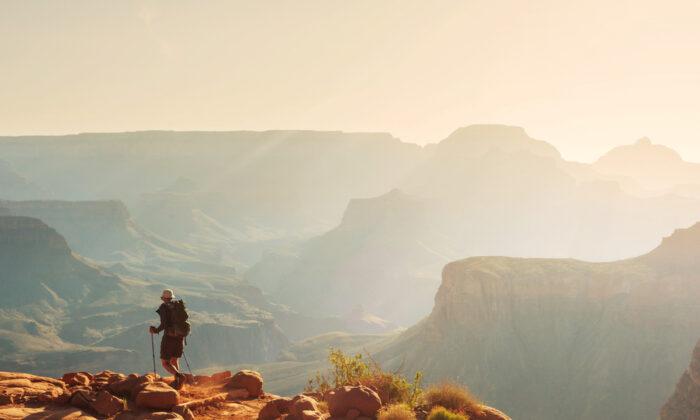The far rim is so distant, it seems to shimmer in an entirely different reality, another world. A place separated, north from south, by a chasm. Normally, canyons are deep and narrow, slender enough that the floor remains in an almost-perpetual shadow, a little silvery sliver of river snaking at the bottom, a fleeting flash of sun reflecting back from that winding thread.
But the Grand Canyon is something else entirely. Riding in a helicopter from the South Rim, the scrubby forest rooted in the red soil of northern Arizona falls away, and below, just an abyss. The Colorado, one of the mighty rivers of the West, flows blue when it’s not frothing white. The extreme depth lays bare layers upon layers of rock, alternating shades of brown, red, and orange. The size of it is hard to grasp.
Geologically speaking, you’re looking at two billion years of history, although most of the recent action dates back only millions or tens of millions of years. (Exactly how many is still an item of hot debate.) The whole place was formed from two powerful, countervailing forces; as the Colorado Plateau pushed up, the Colorado River drilled down, exposing layer after layer of what was once an undersea environment. Volcanic layers are much more recent, dating back only one million years at the most.
Indigenous people have lived here for thousands of years, building communities in the clefts of the rock. Spanish explorer García López de Cárdenas was the first European to spot it back in 1540, led there by Hopi guides, although none more would return here for more than two centuries. President Theodore Roosevelt visited in 1903, and was overwhelmed by the canyon, noting it “fills me with awe” and noting that it is “the one great sight that every American should see.” He designated this huge gorge a national monument in 1908, and Woodrow Wilson created the almost-2,000-square-mile Grand Canyon National Park in 1919. Since then, it’s been recognized as both a UNESCO World Heritage Site and a Natural Wonder of the World.
One of America’s greatest icons, the Grand Canyon is, above all, an almost incomprehensible natural attraction. Yes, it’s instantly recognizable from countless photographs. Like the Taj Mahal, or the Sydney Opera House, or the Eiffel Tower, its image has become almost ubiquitous. But a first approach, striding to the edge, away from the bustle of Grand Canyon Village, is literally unforgettable—even decades later, you’ll remember that feeling of emptiness, the sense that you could never wrap your mind around this endless marvel, no matter how hard you tried.
Hike From Rim to Rim
In a typical year, five to six million visitors visit the canyon, but just a tiny percentage get down to the bottom. And even fewer hike from the North Rim to the South Rim, a journey not for the faint of heart (or the poorly trained). Stretching 24 miles, it’s not the length that will challenge you—it’s the descent and ascent. Connecting North Kaibab Trail and Bright Angel Trail, the trip to the bottom takes you down 6,000 feet, with 4,500 feet of strenuous switchbacks awaiting on the other side. If that sounds like a little too much (it will involve an overnight in a campground or a lodge), tackle just the Bright Angel Trail, from the South Rim, and turn back at Indian Garden. You’ll only get about halfway to the bottom, but you’ll have sweeping views all along the way, and be back by the end of the day.Stay at the Bottom

Walk on Glass
For a spectacular view that doesn’t require an overnight backpacking trip (or many sweaty workouts to prepare), the Skywalk at Grand Canyon West will take you well past the rim. Extending 70 feet out over the floor of the gorge, look down through the glass to gaze at the ground, more than 4,000 feet below. While those afraid of heights will still feel jittery, the designers assure visitors that it’s safe, able to support 70 jumbo jets fully loaded with passengers.Raft on the River

Chopper Over Top

The best view is always from above. Lift off from the South Rim—or Las Vegas, if that’s better—and peer out through the massive windows on an EcoStar helicopter. It’s brief, and amazing, from the heart-pounding moment you stride beneath the rotors and slip into the stadium-style seating on board, to the second the ground falls away to the canyon floor, to the moment you arrive on top of that other world, the North Rim, all the way across the canyon.





